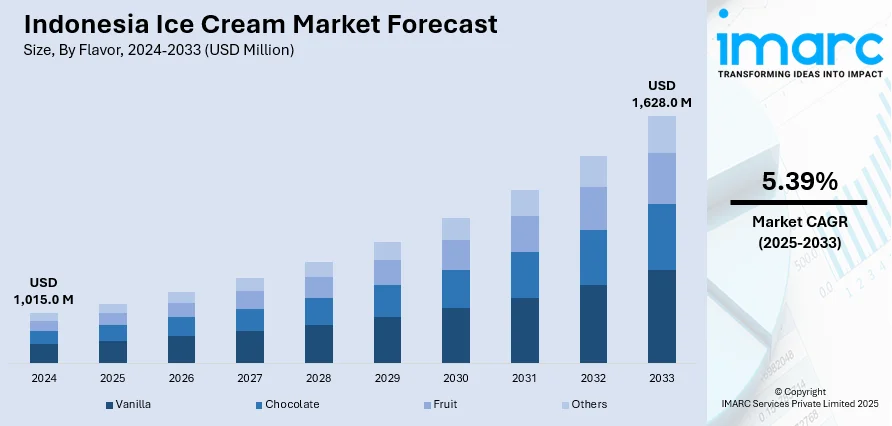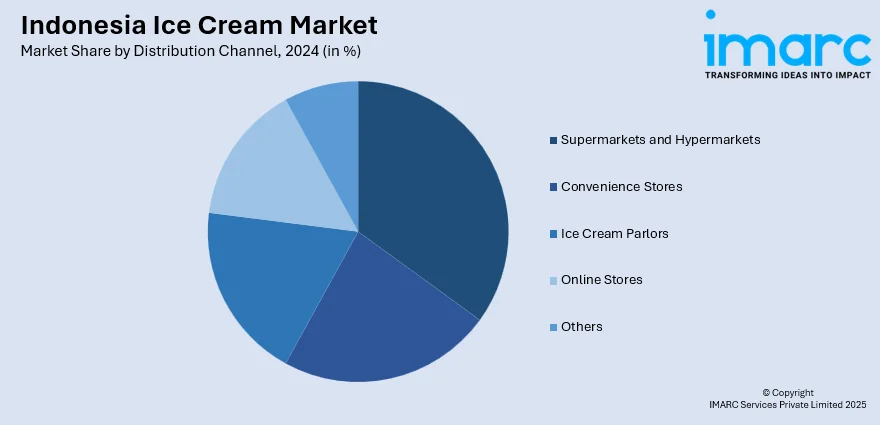
Indonesia Ice Cream Market Size, Share, Trends and Forecast by Flavor, Category, Product, Distribution Channel, and Region, 2025-2033
Market Overview:
The Indonesia ice cream market size reached USD 1,015.0 Million in 2024. Looking forward, IMARC Group expects the market to reach USD 1,628.0 Million by 2033, exhibiting a growth rate (CAGR) of 5.39% during 2025-2033. The rapid urbanization and the rising disposable incomes of individuals, the introduction of several unique and exotic flavors, and the significant expansion in the food service industry represent some of the key factors driving the market.
|
Report Attribute
|
Key Statistics
|
|---|---|
|
Base Year
|
2024
|
|
Forecast Years
|
2025-2033
|
|
Historical Years
|
2019-2024
|
|
Market Size in 2024
|
USD 1,015.0 Million |
|
Market Forecast in 2033
|
USD 1,628.0 Million |
| Market Growth Rate 2025-2033 | 5.39% |
Ice cream is a delightful frozen dessert enjoyed by individuals of all ages around the world. It is a creamy and sweet treat that is typically produced from a few simple ingredients, including milk or cream, sugar, and flavorings. These ingredients are combined and churned while freezing, creating a smooth and velvety texture that makes ice cream so appealing. Milk or cream serves as the base for ice cream, providing a rich and creamy texture. Sugar is added to sweeten the mixture, balancing the flavors and enhancing the overall taste. The amount of sugar used varies depending on the desired sweetness level. Additionally, flavors are important to create several ice cream flavors. Some of the common flavors include vanilla, chocolate, strawberry, and more exotic options including mint chocolate chip or cookies and cream. The freezing process is essential in the making of ice cream, which involves churning the mixture while it freezes and prevents the formation of large ice crystals and, results in a smooth consistency. Some ice cream makers also incorporate air into the mixture during freezing, giving the dessert its characteristic light and fluffy texture. Nowadays, ice cream is easily available in numerous flavors and forms, which can be enjoyed in traditional cones or cups, sundaes, milkshakes, and as an accompaniment to pies and cakes.

To get more information on this market, Request Sample
Indonesia Ice Cream Market Trends:
The market is primarily driven by the rapid urbanization in Indonesia, which is changing the lifestyle and dietary habits of its residents. Urban areas witness a higher concentration of ice cream parlors, dessert shops, and supermarkets, making it easier for consumers to access their favorite frozen treats. Also, the rising disposable income and greater consumer affluence allow individuals to have more purchasing power, leading to the growing demand for premium products, including ice cream, augmenting the market growth. Consumers are now more willing to spend on high-quality ice cream options, including artisanal and gourmet varieties. Moreover, several ice cream manufacturers in Indonesia are quick to adapt to the numerous tastes of consumers and introduce several unique and exotic flavors inspired by local ingredients and cultural preferences catering to the evolving palates of Indonesian consumers, making ice cream a more attractive choice, representing another major growth-inducing factor. Besides this, the rising food service industry, including restaurants, cafes, and dessert shops, is providing a substantial platform for ice cream consumption, which is accelerating the market growth. Also, many food establishments incorporate ice cream into their menus, offering several desserts and sundaes to satisfy customer cravings, augmenting the market growth. Apart from this, the rise of local and artisanal ice cream brands added diversity to the market, allowing these smaller-scale producers to emphasize unique flavors, quality ingredients, and personalized customer experiences, appealing to consumers seeking authentic and premium ice cream experience, are propelling the market growth.
Indonesia Ice Cream Market Segmentation:
IMARC Group provides an analysis of the key trends in each segment of the market, along with forecasts at the country level for 2025-2033. Our report has categorized the market based on flavor, category, product, and distribution channel.
Flavor Insights:
- Vanilla
- Chocolate
- Fruit
- Others
The report has provided a detailed breakup and analysis of the market based on the flavor. This includes vanilla, chocolate, fruit, and others.
Category Insights:
- Impulse Ice Cream
- Take-Home Ice Cream
- Artisanal Ice Cream
A detailed breakup and analysis of the market based on the category have also been provided in the report. This includes impulse ice cream, take-home ice cream, and artisanal ice cream.
Product Insights:
- Cup
- Stick
- Cone
- Brick
- Tub
- Others
The report has provided a detailed breakup and analysis of the market based on the product. This includes cup, stick, cone, brick, tub, and others.
Distribution Channel Insights:

- Supermarkets and Hypermarkets
- Convenience Stores
- Ice Cream Parlors
- Online Stores
- Others
A detailed breakup and analysis of the market based on the distribution channel have also been provided in the report. This includes supermarkets and hypermarkets, convenience stores, ice cream parlors, online stores, and others.
Regional Insights:
- Java
- Sumatra
- Kalimantan
- Sulawesi
- Others
The report has also provided a comprehensive analysis of all the major regional markets, which include Java, Sumatra, Kalimantan, Sulawesi, and Others.
Competitive Landscape:
The market research report has also provided a comprehensive analysis of the competitive landscape. Competitive analysis such as market structure, key player positioning, top winning strategies, competitive dashboard, and company evaluation quadrant has been covered in the report. Also, detailed profiles of all major companies have been provided.
Indonesia Ice Cream Market Report Coverage:
| Report Features | Details |
|---|---|
| Base Year of the Analysis | 2024 |
| Historical Period | 2019-2024 |
| Forecast Period | 2025-2033 |
| Units | Million USD |
| Scope of the Report | Exploration of Historical and Forecast Trends, Industry Catalysts and Challenges, Segment-Wise Historical and Predictive Market Assessment:
|
| Flavors Covered | Vanilla, Chocolate, Fruit, Others |
| Categories Covered | Impulse Ice Cream, Take-Home Ice Cream, Artisanal Ice Cream |
| Products Covered | Cup, Stick, Cone, Brick, Tub, Others |
| Distribution Channels Covered | Supermarkets and Hypermarkets, Convenience Stores, Ice Cream Parlors, Online Stores, Others |
| Regions Covered | Java, Sumatra, Kalimantan, Sulawesi, Others |
| Customization Scope | 10% Free Customization |
| Post-Sale Analyst Support | 10-12 Weeks |
| Delivery Format | PDF and Excel through Email (We can also provide the editable version of the report in PPT/Word format on special request) |
Key Questions Answered in This Report:
- How has the Indonesia ice cream market performed so far and how will it perform in the coming years?
- What is the breakup of the Indonesia ice cream market on the basis of flavor?
- What is the breakup of the Indonesia ice cream market on the basis of category?
- What is the breakup of the Indonesia ice cream market on the basis of product?
- What is the breakup of the Indonesia ice cream market on the basis of distribution channel?
- What are the various stages in the value chain of the Indonesia ice cream market?
- What are the key driving factors and challenges in the Indonesia ice cream?
- What is the structure of the Indonesia ice cream market and who are the key players?
- What is the degree of competition in the Indonesia ice cream market?
Key Benefits for Stakeholders:
- IMARC’s industry report offers a comprehensive quantitative analysis of various market segments, historical and current market trends, market forecasts, and dynamics of the Indonesia ice cream market from 2019-2033.
- The research report provides the latest information on the market drivers, challenges, and opportunities in the Indonesia ice cream market.
- Porter's five forces analysis assist stakeholders in assessing the impact of new entrants, competitive rivalry, supplier power, buyer power, and the threat of substitution. It helps stakeholders to analyze the level of competition within the Indonesia ice cream industry and its attractiveness.
- Competitive landscape allows stakeholders to understand their competitive environment and provides an insight into the current positions of key players in the market.
Need more help?
- Speak to our experienced analysts for insights on the current market scenarios.
- Include additional segments and countries to customize the report as per your requirement.
- Gain an unparalleled competitive advantage in your domain by understanding how to utilize the report and positively impacting your operations and revenue.
- For further assistance, please connect with our analysts.
 Request Customization
Request Customization
 Speak to an Analyst
Speak to an Analyst
 Request Brochure
Request Brochure
 Inquire Before Buying
Inquire Before Buying




.webp)




.webp)












